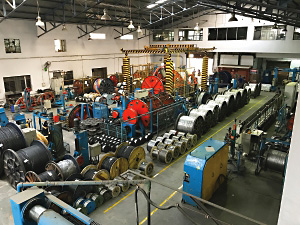To cater to the Govt.’s vision of providing power to all, SBEE Cables saw an opportunity to revamp its manufacturing capability by inducing significant automation in its facilities and broadening its wire and cable portfolio.

SBEE Cables, an independent family owned company, manufacturing wires and cables, has evolved much with time. Primarily manufacturing the components for the lighting industry, it started manufacturing submersible winding wires, submersible flat cables, and domestic wires later on seeing the maturity of its earlier product range. Going forward, it diversified its portfolio to include LV cabling solutions. Moreover, for its timely delivery and excellent product range, it fast became a preferred choice for many reputed OEMs globally.
WCI recently held a brief interaction with Mr. S. Bhawarlal, Managing Director, SBEE Cables (India) Limited to know more about the company’s priority and strategy in times to come. Excerpts:
Wire & Cable India: Kindly brief us about the company, its inception, and evolution.
S. Bhawarlal: The company was founded in 1978 as Mahadev Vidhyuth Udhyog Pvt. Ltd. Keeping in mind the large requirement of GLS lamps at that time, it embarked upon the production of tungsten wires and lead wires required in GLS lamps. At that time, the GLS lamp was on its maturity curve. With the evolution in the lighting industry as time passed, we saw bleak future of GLS lamps. Hence, we started pondering about other allied business opportunities. With our experience in wire drawing and electrical industry and seeing the future of power sector, the natural decision was to make an entry into house wires.
WCI: Prior to 1995, SBEE Cables was engaged primarily in the manufacturing of components for the lighting industry, which it discontinued and started manufacturing submersible winding wires, submersible flat cables, and domestic wires. What factors then were responsible for you to become a wire and cable manufacturer?
SB: There was a thrust in agriculture sector where in the state governments were subsidizing installations of submersible pumps. With rising demand and knowing that Indian economy has a large dependence on agriculture, our interest and investment went for the manufacture of the winding wires and flat cables for submersible pumps. REC (Rural Electrification Corporation) was also investing large funds on rural electrifications and hence we went into the production of housing wire.
As the entry cost in housing wire and cables for submersible pumps sector was very low, the industry started getting crowded. It was therefore felt that if the thrust of the 5 years plan of the Government of India is in the growth of power, agriculture, and infrastructure, the cable industry will be the right field to be in. However, to make it a long-term business proposition, we should be enhancing the range and manufacturing capability.
WCI: SBEE Cables later on diversified into a range of LV cabling solutions. Can you give us the details of your offerings with their applications?
SB: By late 1990s and early 2000s, the government had started giving emphasis on the slogan ‘Power for All’. That is the time when the organization decided that if we had to make an impact and grow, the answer would be to modernize, bring in automation and expand. With this objective, the company embarked upon automating the process of manufacturing. The company also enhanced the range of cables keeping in mind varied sectors and applications such as power, control, signal, single core, multicore etc.
The Govt.’s spending in infrastructure and power sector were increasing, private investments in cement, steel, automobile pharmaceutical etc., were coming in at rapid pace, which in turn was generating large demands for cables.
WCI: SBEE has been recognized for its quality offerings and has been supplier a to reputed OEM clients. What’s the major USPs of your products that make you a preferred choice for all these top companies?
 SB: ‘SBEE’ brand by then had started making its presence felt. With aggressive marketing and commitment to quality, the brand started getting acceptance in OEM segment. This segment is sensitive to on-time delivery and consistency in quality. That is where SBEE encashed since these are its strengths; until then SBEE was only a local brand. With an entry into such OEMs, who had their manufacturing facilities outside Karnataka also, SBEE started spreading its network outside Karnataka as well.
SB: ‘SBEE’ brand by then had started making its presence felt. With aggressive marketing and commitment to quality, the brand started getting acceptance in OEM segment. This segment is sensitive to on-time delivery and consistency in quality. That is where SBEE encashed since these are its strengths; until then SBEE was only a local brand. With an entry into such OEMs, who had their manufacturing facilities outside Karnataka also, SBEE started spreading its network outside Karnataka as well.
With this evolution, there was an increase in the range of products, market segments, customer’s base, new geographical areas, etc. This started the thought process of having a larger manufacturing facility with the lean process. With this in mind, the company acquired a large piece of land at Harohalli Industrial Area, which is in outskirts of Bangalore. The objective was to have state of art facility with automation so that there is least human interference while maintaining quality.
WCI: You were to move into your new facility in the year 2017. What’s the status with regard to that and what all are you going to produce there? Please specify the products, technology applied, and capacity to be produced regarding the new facility. Is there any other expansion plan in the offing?
SB: The civil and electrical work at our new facility should be completed by the last quarter of the current year when we hope to start the trial production. Initially, we will continue to the present and its extended range but with better process and methods. In doing so, we shall be using state-of-the-art technology, modern and higher speed machines with automation which will help us to offer products of international quality standards to industry.
In the 2nd phase of our expansion, we also propose to enter into the range of medium voltage cable.
WCI: Tell us about the latest global trends with regards to technology, raw material, and product types in the wire and cable industry, which SBEE is also a part of. Give us an innovative product which is true as per the latest trend and a game changer for SBEE Cables.
SB: As of today, there is no replacement to copper or aluminum as a conductor. Over the years, there have been improvements in purities of these metals and also in insulation and other plastic materials. There have been new constructions of wires and cables due to varied applications and revolution in IT industry. RF cables, data cables, co-axial cables, and communication cables are some of such examples. Aviation and defense industry has requirements of highly sophisticated and special cables. Entry into all these segments with advanced manufacturing process could be again a game changer. All such products do require special raw materials and processes.
WCI: What is the growth outlook for the industry for the next 3-5 years? Where do you see (segment) the maximum growth happening for the wire and cable industry? Give us an outline of various challenges that the industry is facing. What are your expectations from the Govt. in addressing those challenges?
SB: Lifestyles are changing, per capita income is increasing, information technology is taking deeper roots, and digitization is spreading. All these factors will see growth in per capita consumption of KWH and white goods industry.
Overall, we are looking at an annual growth of about 7 to 8 percent in LV cables sector. However, this will not be uniform in the entire segment. We expect larger growth in distribution of power and consumer sector.
These assumptions are derived from the fact that if PLF (Plant Load Factor) of the power station is improved, transmission losses are reduced and power theft is checked; there may not be any necessity for setting up new power plants for at least next 2 to 3 years. Power, thus, saved would have to be transmitted and consumed. This saving will be sufficient to meet the increased demand of power in shorter time scale.
Still, large quantities of LV cables and wires are being imported in one form or another. This is dampening the growth of Indian industry. The government may have to look ways and means to discourage/stop this. To give an example, wires are being imported in the form of harness and chords in large quantities.
In addition, the government should also look into ways and means of making this industry grow at faster pace. This is because it falls into the priority sector, which is POWER.




